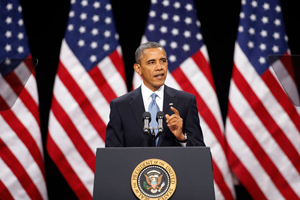Washington, Oct 22: WikiLeaks has revealed US President Barack Obama's private email address by publishing hacked emails, in another potentially embarrassing document dump targeting the Democrats, a media report said.
 "WikiLeaks reveals first batch of US President Barack Obama emails sent via secret address," WikiLeaks, the Julian Assange-founded open secrets site, tweeted on Thursday — implying that even more of Obama's private communications would be released.
"WikiLeaks reveals first batch of US President Barack Obama emails sent via secret address," WikiLeaks, the Julian Assange-founded open secrets site, tweeted on Thursday — implying that even more of Obama's private communications would be released.
According to the New York Post, the site published seven messages involving an email address purported to be that of the commander-in-chief: [email protected].
One exchange was dated the evening of November 4, 2008 — Election Day. John Podesta, co-chair of Obama's transition team, urges Obama not to accept an invitation to a G-20 meeting in November 15 on the global financial crisis should outgoing President George W. Bush invite him that night after Obama is officially elected.
Podesta attached a memo the transition team prepared weighing the pros and cons of going to the summit.
"On the chance that President Bush would raise this with you tonight, I wanted you to be aware that it is the unanimous recommendation for your advisors that you NOT attend," Podesta said.
When the G20 convened in Washington, Obama was absent.
An email message sent on Thursday to Obama's alleged address didn't bounce back immediately — signalling it could still be a working account.
The White House declined to comment. The US intelligence authorities believe Russia orchestrated the widespread cyber attacks into Democratic Party-related emails.
The Obama messages were among some 23,000 emails stolen from Podesta, who now serves as Democratic presidential nominee Hillary Clinton's campaign chairman, the New York Post reported.
The alleged Obama emails were from 2008 when the young Illinois senator was about to win his historic White House bid and was assembling a transition team. The emails largely address staffing a transition economic team and adding diversity to a future Obama administration.
WikiLeaks reveals first batch of US president Barack Obama emails sent via secret address [email protected] https://t.co/Ni95WAl8a6
— WikiLeaks (@wikileaks) October 20, 2016





Comments
Add new comment